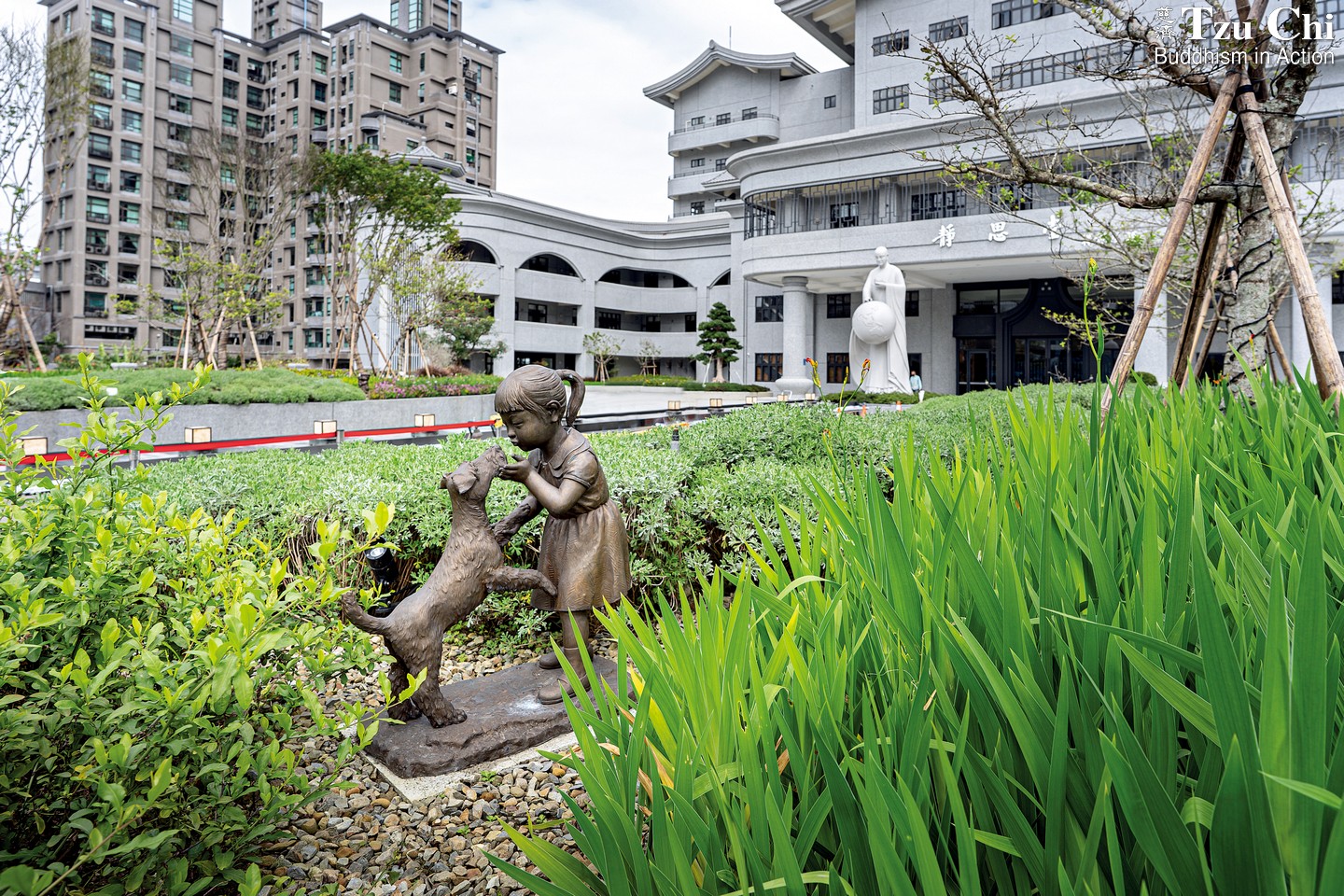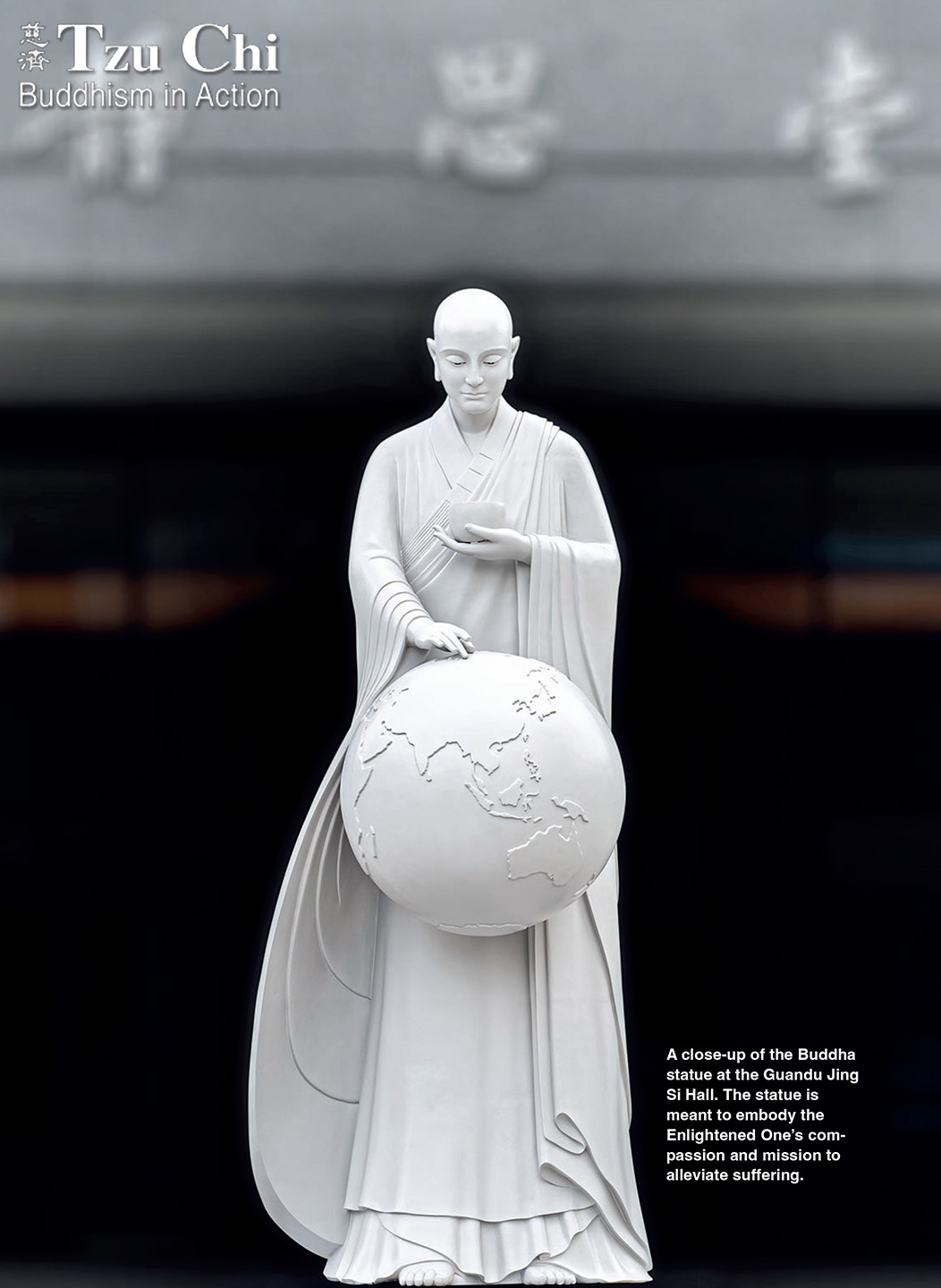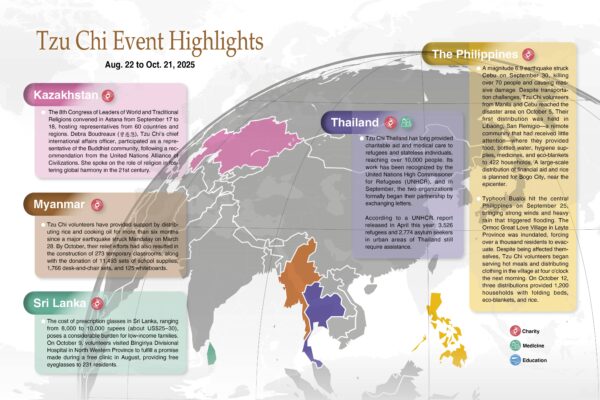Compiled by Tzu Chi Monthly editorial staff
Translated by Wu Hsiao-ting
Photos by Hsiao Yiu-hwa
The newly opened Guandu Jing Si Hall offers a welcoming and serene setting, reflecting the spirit of Buddhism through sculpture, landscaping, and symbolic representation.

A statue of the Buddha stands tall under the clear sky in the background of the herbal garden located in the square in front of the Guandu Jing Si Hall. It is as though he is looking upon all sentient beings with compassion.
The Guandu Jing Si Hall, the new home of Tzu Chi’s media, was inaugurated on New Year’s Day, 2023. Located in Guandu, on the outskirts of Taipei City, the Jing Si Hall is welcoming and visitor-friendly: it has no wall around it and visitors can enter without having to take off their shoes. These features, coupled with its elegant building and lush, beautiful surroundings, have attracted many people to visit in the months since its opening.
Visitors are greeted by refreshing, vibrant greenery and a 37-meter-long waterway as soon as they enter the grounds of the Jing Si Hall. Eric Yao (姚仁祿), who manages Tzu Chi’s media, explained the background of the beautiful campus. In November 2020, during a visit to the near-completed facility, Dharma Master Cheng Yen expressed her hope that the square in front of the hall would be full of soft and beautiful greenery to invite passersby to joyfully enter. She even expressed her desire that drivers stuck in traffic on Lide Road in front of the square would be calm and buoyed by looking at the peaceful atmosphere of the square. The Master suggested using medicinal herbs as a key design feature for the square’s landscaping and that a waterway with upward-flowing water be incorporated to symbolize perseverance and triumph over adversity.
Based on the Master’s instructions, Yao envisioned creating a square for the Jing Si Hall that would be “friendly and approachable” while maintaining a sense of “grandeur and solemnity.”
A garden with a rich variety of medicinal herbs was subsequently planted in the square in hopes of piquing visitors’ curiosity and encouraging them to explore deeper into the grounds. In the midst of the herbal garden is a 37-meter-long waterway where the water flows upwards. At the end of the waterway stands an impressive 5.5-meter-tall off-white statue of the Buddha. Combining sculptural landscaping, aesthetic beauty, and the spirit of Buddhism, this modern statue of the Buddha holds in his left hand a bowl that symbolically contains pure water, which represents wisdom. With his right hand, he sprinkles pure water over and lightly rests his fingers on the sphere of the Earth; this signifies his compassion for all living beings. Like the front garden, the design of the statue was in accordance with Master Cheng Yen’s original concept.
A team was formed to create this statue of the Enlightened One, with members in charge of various tasks: art direction, figure molding, 3D modeling, 3D printing, bronze casting, surface coating, and more. Yao, who served as the art director, shared that the most challenging aspect of the sculpture was not achieving the softness of the clothes or creating the posture of the body, but capturing the expression on the Buddha’s face. In addition to a gentle, compassionate look, they portrayed the Buddha as being in his 30s or early 40s, highlighting the fact that Buddhism was founded by a young person. The statue is situated in an open area, with no barriers, welcoming the public.

The Hall of Innumerable Meanings
Tzu Chi volunteer Xu Rui-zhen (許瑞珍) often receives visitors to the Jing Si Hall. She points out that the Buddha statue is set upon a six-lobed base. She explains that the six bell-shaped lobes represent the Six Paramitas (Perfections) taught by the Buddha to guide individuals on their paths of spiritual cultivation: giving, moral discipline, patient endurance, diligence, meditation, and wisdom.
The waterway in front of the statue features historical highlights of Tzu Chi etched on one side of the bottom, and highlights of world history etched on the other side. This design symbolizes the connection between Tzu Chi’s work and worldly affairs, emphasizing that the foundation’s missions are grounded in the realities of the world and aimed at benefiting all living creatures. Just as it is stated in the Ekottarika Agama, “All buddhas arise from this world and none from heaven,” affirming the importance of working towards the betterment of the world. The waterway is 37 meters long, representing the 37 Principles of Enlightenment that guide spiritual practitioners on the Bodhisattva Path. There are 20 lamps along the length of the waterway, symbolizing the 20 Challenges to Enlightenment.
Elaborating further on the metaphorical meaning of the waterway, Xu said that the Dharma (the Buddha’s teachings) is often compared to water, as it has the power to purify the mind and nourish all living beings. The movement of the water within the waterway represents the flow of Tzu Chi’s Dharma lineage, which is like a powerful spring that never ceases to flow. The water flows upwards, just as the path of a bodhisattva is challenging yet achievable. “The development of Tzu Chi’s missions is also like this,” said Xu. “In the face of ever-changing circumstances, we must bring forth wisdom. In the face of difficulties, we must develop resilience. As we overcome obstacles, we create blessings and move forward with greater courage.”
As visitors step in from outside, they enter the Hall of Innumerable Meanings, named after the Sutra of Innumerable Meanings. This sutra forms the foundation of Tzu Chi’s Dharma lineage and holds great significance for all those who follow the Tzu Chi Path. The Hall of Innumerable Meanings features a massive LED screen composed of 46 55-inch displays. They showcase Master Cheng Yen’s hand-written text of the sutra. This hand-written text slowly scrolls across the LED screen in a rotating fashion, creating a seamless display of the sutra’s content. Without the need to physically flip pages, visitors can easily read this electronic scripture, surrounded by the calming music of “Six Auspicious Signs” and the soothing aroma of sandalwood. The entire sutra can be recited in 80 minutes.
During the inauguration of the Guandu Jing Si Hall on New Year’s Day, Wang Tuan-cheng (王端正), CEO of the Tzu Chi mission of culture, and Eric Yao together placed an oval metal plate inscribed with the words “Guarding Stone of Wisdom” and its Chinese equivalent into the floor of the Hall of Innumerable Meanings. Standing before this metal plate, facing the LED screen with its starry sky backdrop, one can look up and see the North Star on the screen, the only motionless star in the night sky. Xu Rui-zhen explained the symbolic meaning of this design: “Over 2,500 years ago, the Buddha looked up at the sky, saw a bright star there, and attained enlightenment. Following his awakening, the Enlightened One proclaimed that all living beings have a buddha nature and are capable of the same awakening as he. By following the Buddha’s teachings and practicing with unwavering perseverance, we can ultimately attain great wisdom and fully comprehend all things.”

The Hall of Innumerable Meanings displays a rotating, hand-written text of the Sutra of Innumerable Meanings on a massive LED screen. The calligraphy was created by Dharma Master Cheng Yen.
A landmark of Tzu Chi’s cultural mission
The Guandu Jing Si Hall offers more than just a beautiful setting and creative designs; visitors can also grab a book or a cup of coffee at the Jing Si Books & Café on the premises. Upon entering the store, guests are greeted by an elegant ambience and a neatly arranged collection of books on display. Six circular lights adorn the ceiling, representing the Six Paramitas. The tables and chairs, with a stylish black and white color scheme, complement the overall decor. According to one staff member, “We are gradually reducing our printed publications and transitioning to e-books for book displays. In the café, visitors can savor a cup of pour-over coffee and take their time to unwind.” Plans are also in the works for a dedicated space where parents and children can read together or participate in storytelling sessions.
The Guandu Jing Si Hall is also the headquarters of Tzu Chi’s cultural mission, which encompasses various forms of media, including Da Ai TV, internet broadcasting, and magazine and book publishing. It is also an educational venue for lifelong learning for members of the community, offering diverse courses and contributing to the betterment of the community.
The premises also include a DA.AI Technology store and a FamilyMart vegetarian convenience store. (DA.AI Technology is a social enterprise founded by some entrepreneurs who share Tzu Chi ideals). A vegetarian restaurant named “常不輕食堂” in Chinese, which translates to “Sadaparibhuta Cafeteria,” is in the planning stages. The restaurant is named after Bodhisattva Sadaparibhuta, mentioned in the Lotus Sutra. This is to encourage everyone to learn from the bodhisattva’s spirit and to respect, cherish, and be grateful to all lives and things. The name of the restaurant in English will be “Dandelion,” symbolizing the plant’s ability to spread its seeds and grow new life. The ultimate goal is to open more “Dandelion” restaurants and through them, to promote vegetarianism.
Back to the square in front of the Jing Si Hall, there are currently more than 40 types of herbs planted, including plumeria (frangipani), sage, osmanthus, mondograss, and perilla, each with medicinal value. The herbal garden is not only beautifully landscaped but also has educational significance. Xu Rui-zhen pointed out that herbs may be small, but they have potent therapeutic powers. “All plants have medicinal properties; every living thing has valuable abilities and qualities,” she said. “From small herbs, we can learn to think of ourselves and never underestimate our potential.”
●
Master Cheng Yen emphasizes that the purpose of creating a Buddha statue is not to provide an object of worship but to convey the inner state of the Buddha, a concrete manifestation of his love for the world and his mission to alleviate suffering. After a tour around the Guandu Jing Si Hall, one can look back at the statue of the Buddha on-site with his hand gently touching the Earth and reflect on his compassionate heart and wisdom. It is important to remember at the same time that paying respects to the Buddha is also a way of honoring the pure Buddha nature that resides within each person’s heart.



